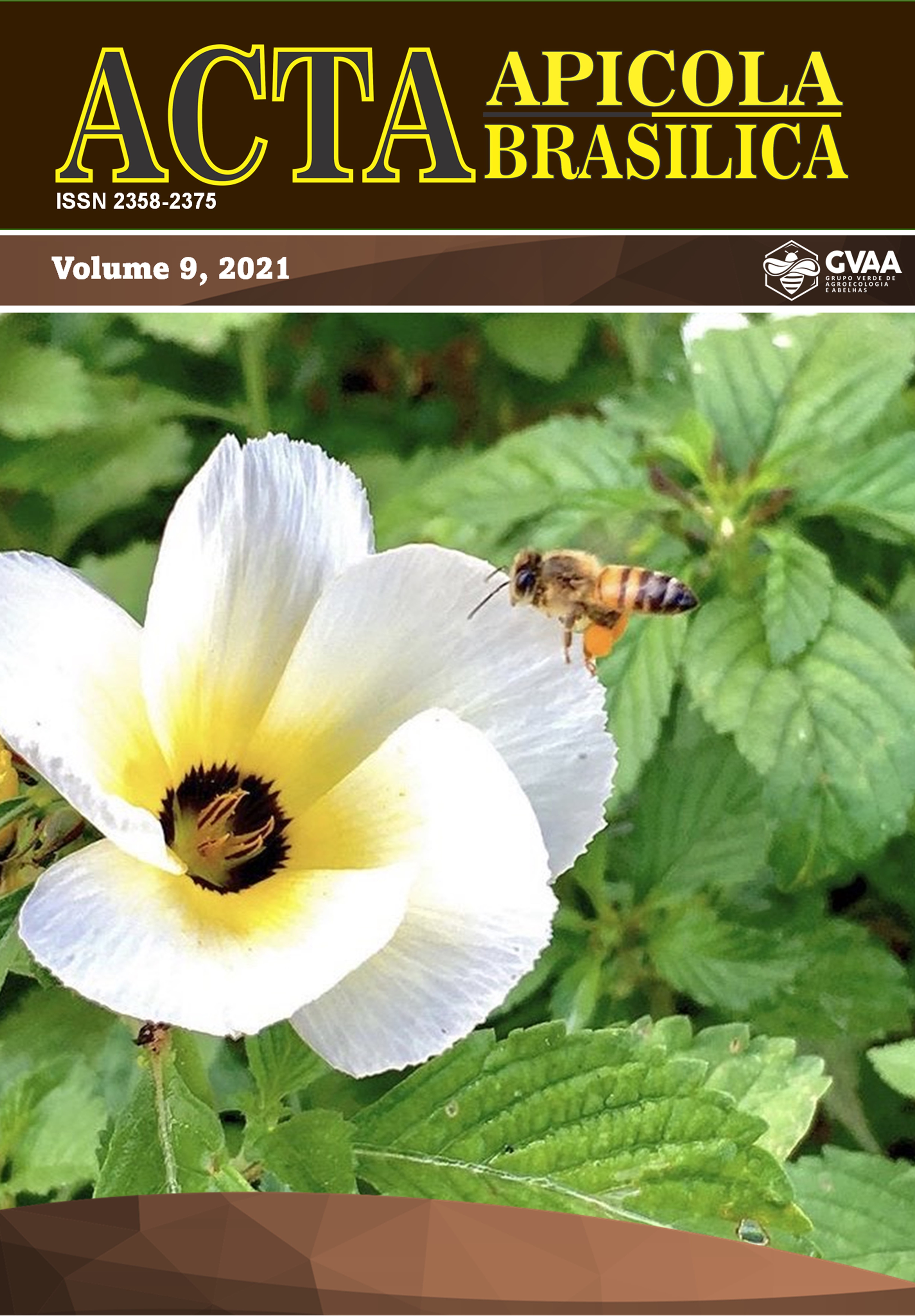Social behavior between Apis mellifera and Tetragonisca angustula bees
DOI:
https://doi.org/10.18378/aab.9.7983Keywords:
Jatai, Colony, Coexistence, HarmonyAbstract
Bees are insects of great use to man, live in harmony with nature and are the main pollinators of floral species, being the main responsible for the production of food on the planet. The species Apis mellifera L. and Tetragonisca angustula (Latreille, 1811) have production capacity that can be commercialized, but created in different ways, with their own hives developed for each species. Due to this fact, there was an interest in researching whether these species of similar social lives could live harmoniously in the same hive. The research was carried out with the objective of evaluating the social life among A. mellifera and T. angustula bees. The experiment used ten hives of A. mellifera with an estimated population of approximately 20,000 bees, with a nest and a hedgehog with an excluding screen. Five frames were removed from the melgueira and a swarm of Jataí bees (T. angustula) was introduced into the frame space with a population assessment of approximately 1,000 bees. Six months after the preparation of the hives, the sociability between the studied species and the evolution of the prepared swarms were evaluated, considering the amount of food stored, the estimated number of bees and the space reserved for each swarm. The data extracted from the research show that the bees A. mellifera and T. angustula can live harmoniously in the same space, without interference between the swarms.
Downloads
References
ALMEIDA, A. M. de. Diagnóstico da apicultura e da meliponicultura em comunidades ribeirinhas do Pantanal. Corumbá: Embrapa Pantanal, 2016. 37 p.
ALVARES, C. A., STAPE, J. L., SENTELHAS, P. C., GONÇALVES, J. L. M.; SPAROVEK, G. Köppen’s climate classification map for Brazil. Meteorologische Zeitschrift, v.22, n.6, p.711-728, 2013. DOI: https://doi.org/10.1127/0941-2948/2013/0507
CAMARGO, J. M. F.; PEDRO, S. R. M. Meliponini Lepeletier, 1836. In: MOURE, J. S.; URBAN, D.; MELO, G. A. R. (Orgs). Catalogue of Bees (Hymenoptera, Apoidea) in the Neotropical Region - online version, 2012.
CORTOPASSI-LAURINO, M. Abelhas em agronegócios. VI Seminário Nordestino de Pecuária - Apicultura, Fortaleza, CE, Anais..., p. 5-11, 2002.
FERREIRA, E. A.; PAIXÃO, M. V. S.; FERREIRA, A. V.; KOSHIYAMA, A. S.; LORENZON, M. C. A. Pedagogical Workshop as a Learning Tool in Meliponiculture. v.7, n.3, p.442-452, 2020a. DOI: https://doi.org/10.22161/ijaers.73.62
FERREIRA, E. A.; FREITAS, S. P. DE; BANDEIRA, O. H. S.; CALAÇA, P. S. S. T.; PAIXÃO, M. V. S.; VIEIRA, K. I. C. Plantas cultivadas com potencial para meliponicultura em agroecossistema orgânico na região serrana do Estado do Espírito Santo. Brazilian Journal of Development. Curitiba, v.6, n.11, p.88134-88144, 2020b. DOI: https://doi.org/10.34117/bjdv6n11-292
GRÜTER, C.; MENEZES, C.; IMPERATRIZ-FONSECA, V. L.; RATNIEKS, F. L. W. A morphologically specialized soldier caste improves colony defense in a neotropical eusocial bee. Proceedings of the National Academy of Sciences of the United States of America. v.109, n.4, p.1182-1186, 2012. DOI: https://doi.org/10.1073/pnas.1113398109
INCAPER. Planejamento e programação de ações para Santa Teresa. Programa de assistência técnica e extensão rural PROATER, Secretaria de Agricultura, 2011.
JARAU, S.; HRNCIR, M. Social insects and the exploitation of food sources - Concluding thoughts. In Food exploitation by social insects: ecological, behavioral, and theoretical approaches (ed. Jarau, S. and Hrncir M.). Boca Raton, London, New York: CRC Press, Taylor & Francis Group. 2009. DOI: https://doi.org/10.1201/9781420075618
MARTINS, G.; FERRAZ, R. L. DE S.; BATISTA, J. L.; BARBOSA, M. DE A. Incentivo para o plantio de árvores nativas em áreas urbanas para proliferação de abelhas sem ferrão. ACTA Apicola Brasilica, v.3, n.2, p.01- 9, 2015. DOI: https://doi.org/10.18378/aab.v3i2.3449
NOGUEIRA-NETO, P. Vida e criação de abelhas indígenas sem ferrão. São Paulo: Nogueirapis, 1997. 446p.
REIS, V. D. A. dos; PINHEIRO, R. da S. Fundamentos para o desenvolvimento seguro da apicultura com abelhas africanizadas. Corumbá: Embrapa Pantanal, 2011. 32p.
SANTIAGO, L. R. Variabilidade genética de Tetragonisca angustula (Hymenoptera, Apidae, Meliponini) de meliponários. 2013, 119p., Dissertação de Mestrado, Universidade de São Paulo. São Paulo, 2013.
SANTOS, A. B. Abelhas nativas: polinizadores em declínio. Natureza online, v.8, p.103-106, 2010.
SILVA, G. R. da; PEREIRA, F. de M.; SOUZA, B. de A.; LOPES, M. T. do R.; CAMPELO, J. E. G.; DINIZ, F. M. Bioecological and behavioral genetic aspects involved in the conservation of the stingless bee Melipona subnitida Ducke (Apidae, Meliponini) and the use of molecular tools in studies of diversity. Arquivos Instituto Biologia, v.81, n.3, p. 299-308, 2014. DOI: https://doi.org/10.1590/1808-1657000812012
SOUSA, J. M. B. Perfil bromatológico de mel de abelha sem ferrão produzido na microrregião do Seridó do Rio Grande do Norte. 71p., 2011, Dissertação de Mestrado, Bananeiras, Universidade Federal da Paraíba, 2011.
VILLAS-BÔAS, J. Manual Tecnológico: Mel de abelhas sem ferrão. Brasília: Instituto Sociedade, população e Natureza (ISPN), Brasil, 2012.
Downloads
Published
How to Cite
Issue
Section
License
Copyright (c) 2021 Marcus Vinicius Sandoval Paixão et al.

This work is licensed under a Creative Commons Attribution 4.0 International License.















